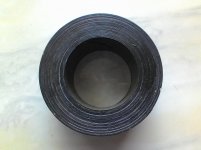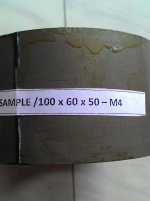Hi
Few days ago I got sample of toroidal core from my friend. I don't know any technical details of core just know OD-10cm, ID-6cm, height- 5cm and wet about 1.845 kg(M4 grade). I want to make toroidal transformer using this core but how to calculate core area and maximum VA capacity of core.I take some photos and attach.
please help me.
Few days ago I got sample of toroidal core from my friend. I don't know any technical details of core just know OD-10cm, ID-6cm, height- 5cm and wet about 1.845 kg(M4 grade). I want to make toroidal transformer using this core but how to calculate core area and maximum VA capacity of core.I take some photos and attach.
please help me.
Attachments
The core area is simply core thickness times core height.
Thickness is {100mm-60mm}/2 = 20mm
You should be able to confirm that by measurement.
VA is somewhere from 80VA to 150VA.
Is this a mains transformer?
Be very careful how you insulate the primary winding from both the core and from the secondary/ies.
Thickness is {100mm-60mm}/2 = 20mm
You should be able to confirm that by measurement.
VA is somewhere from 80VA to 150VA.
Is this a mains transformer?
Be very careful how you insulate the primary winding from both the core and from the secondary/ies.
Last edited:
Thanks AndrewT
yes you are right But how do you calculate maximum VA of core. it is Mains transformer
yes you are right But how do you calculate maximum VA of core. it is Mains transformer
Last edited:
roughly as
VA = core area squared * max Flux
for 2cm * 5cm Area = 10cm²
VA = 10*10*0.75*Flux
for 0.7874" * 1.969" area = 1.55inch²
VA = 1.55*1.55*31*Flux
Flux in both cases is Tesla. 0.6 for low grade EI, to 1.8 for high grade toroid.
Both formulae are for 50Hz.
I'm sure all this is in the transformer Threads.
There is some discrepancy about the use of area squared.
Expect some counter argument.
VA = core area squared * max Flux
for 2cm * 5cm Area = 10cm²
VA = 10*10*0.75*Flux
for 0.7874" * 1.969" area = 1.55inch²
VA = 1.55*1.55*31*Flux
Flux in both cases is Tesla. 0.6 for low grade EI, to 1.8 for high grade toroid.
Both formulae are for 50Hz.
I'm sure all this is in the transformer Threads.
There is some discrepancy about the use of area squared.
Expect some counter argument.
dear andrewT
thanks for your cooperation. But in Following page Transformers Part 2 - Beginners' Guide to Electronics in Table 11.1 - Typical Toroidal Transformer Specifications. core mass to VA relation is different from your calculation .if that table is right my core is between 160 to 225VA.I am bit confuse.
thanks for your cooperation. But in Following page Transformers Part 2 - Beginners' Guide to Electronics in Table 11.1 - Typical Toroidal Transformer Specifications. core mass to VA relation is different from your calculation .if that table is right my core is between 160 to 225VA.I am bit confuse.
to VA relation is different from your calculation .if that table is right my core is between 160 to 225VA.I am bit confuse.
None of these calculations are correct unconditionally, they are only estimations, or calculations only for 1 specific case. What is always true for a core is V/turn=4.44×A×Bmax×f (for sine wave). The current×turn is always dependent on the details of the winding (fill factor, allowable temperature) and the environment (ambient temperature, air flow) and the mode of usage (constant load or cyclical load), and the allowable voltage drop with the intended rectifier circuit, so telling any VA number without knowing/mentioning these details is a ********.
Current×turn can be calculated in 2 different ways, depending on the type of usage. If you want to use it in continuous operation, and don't care about load regulation (voltage drop caused by load), then you can calculate the so called thermal rating. This is the more common specification, however not really relevant in case of audio amplifiers operating in Class AB, D, G, H or T. Good almost only for Class A among audio usage.
For strongly variable load like audio power in most cases the limiting factor is not heat, but voltage drop. In these cases you have to calculate drop limited power, which depends on the allowable drop and fill factor.
For strongly variable load like audio power in most cases the limiting factor is not heat, but voltage drop. In these cases you have to calculate drop limited power, which depends on the allowable drop and fill factor.
So dear pafi
Which is best method for calculating core area and va .
Core area is height×thickness.
For VA the best method DEPENDS ON THE REQUIREMENTS. If you only need a number without knowing what it means, then you can choose any calculation.
For VA the best method DEPENDS ON THE REQUIREMENTS. If you only need a number without knowing what it means, then you can choose any calculation.
Core area is height×thickness.
For VA the best method DEPENDS ON THE REQUIREMENTS. If you only need a number without knowing what it means, then you can choose any calculation.
Dear pafi
what else you want to know about core i think CRGO material M4 is have 1 to 1.5T/50Hz with 0.8 to 1.2watt lose per kg and strips width about 0.25 to 0.29mm now can you help.
I repeat 1 thing again at once, maybe it will go through: current goes through copper, not on iron. Amper rating depends on the coils, not the core.
There are some other things I wrote and ignored, but 1 thing at a time, to make easier to follow.
There are some other things I wrote and ignored, but 1 thing at a time, to make easier to follow.
You gave us this. How does he/we use that?.............. What is always true for a core is V/turn=4.44×A×Bmax×f (for sine wave)................
How does it get him closer to the VA of his core?
Last edited:
1. VA=V×A=V/turn×A×turn. Core determines V/turn by the formula I wrote. It is simple and correct. Now only A×turn should be calculated.
2. In every cases V/turn is needed for winding a transformer. Calculating back from other, less precise formulas is pointless and leeds to misunderstanding.
Core itself determines voltage, not current. The keys for current are fill factor and (temperatures and/or usage and allowable drop on the specified type of load).
These dependancies are discussed in every correct discussion of transformer designs, mentioned on esp pages also.
2. In every cases V/turn is needed for winding a transformer. Calculating back from other, less precise formulas is pointless and leeds to misunderstanding.
Core itself determines voltage, not current. The keys for current are fill factor and (temperatures and/or usage and allowable drop on the specified type of load).
These dependancies are discussed in every correct discussion of transformer designs, mentioned on esp pages also.
Hi
Few days ago I got sample of toroidal core from my friend. I don't know any technical details of core just know OD-10cm, ID-6cm, height- 5cm and wet about 1.845 kg(M4 grade). I want to make toroidal transformer using this core but how to calculate core area and maximum VA capacity of core.I take some photos and attach.
please help me.
Dear pafi
what else you want to know about core i think CRGO material M4 is have 1 to 1.5T/50Hz with 0.8 to 1.2watt lose per kg and strips width about 0.25 to 0.29mm now can you help.
compare your core to some of these....Silicon Steel Toroidal Cores - In Stock
m4 is a lot better than m6.....toroids can operate at higher flux densities than EI's since there is virtually no air gaps...
uses less copper than a comparable EI...
VA is somewhere from 80VA to 150VA.
How to determine my core is 80VA or 150VA please make clear to me.
toroids can operate at higher flux densities than EI's since there is virtually no air gaps.
There is virtually no relation between air gap and allowable flux density.
How to determine my core is 80VA or 150VA please make clear to me.
A core can transform ZERO power. Windings can transform electricity. As long as you don't fix the details of the windings and usage the power is not determined.
Start by trying 3 turns per volt on your primary. Figure 1.5 amps for the current rating at 120 volts and .75 for 240 volts. Or a bit thicker than 20 gauge at 120 volts or 23 gauge for 240 volts. Test the transformer with the primary only wound in series with a light bulb. A 25 watt incandescent lamp should barely glow when in series with the primary winding. The core may get warm to the touch if left on for a day or so, but no too warm to hold.
this is how it is done in a video....https://www.youtube.com/watch?v=Q6GkSNfAEx4
dear AJT
I already watch this video detail website for this video is as follows
construya un transformador toroidal casero
In this page toroidal core Maximum VA determine by simply squaring the core area. Is this right method for calculating VA.Through this method My toroidal core is 100 VA maximum but its wet is 1.8kg Can core wet do nothing in calculation. Because in EI lamination transformer core wet is almost double compare to Toroidal core with same VA rating. I have one EI transformer with about 180VA its Core wet without copper is 1.95kg.Now How to calculate Core Mximum VA capacity?
Last edited:
Pafi disagrees but has not shown how to design for a particular VA rating.
The generally adopted formulae I gave in post4 give a good estimate.
Pafi has not given any alternative, nor has he shown us how to apply his formula to finding VA.
post5 shows
Toroid steel can generally support a higher flux value and that results in lighter cores.
Using V/Turn = 4.44 * Area * Bmax * Freq gives 4.44 * 0.02m * 0.05m * 1.8T * 50Hz = 0.3996V/Turn or 2.5Turns/Volt for a good steel toroid.
The generally adopted formulae I gave in post4 give a good estimate.
Pafi has not given any alternative, nor has he shown us how to apply his formula to finding VA.
post5 shows
V/turn=4.44×A×Bmax×f (for sine wave)
Toroid steel can generally support a higher flux value and that results in lighter cores.
Using V/Turn = 4.44 * Area * Bmax * Freq gives 4.44 * 0.02m * 0.05m * 1.8T * 50Hz = 0.3996V/Turn or 2.5Turns/Volt for a good steel toroid.
Last edited:
- Home
- Amplifiers
- Power Supplies
- Toroidal core calculation

